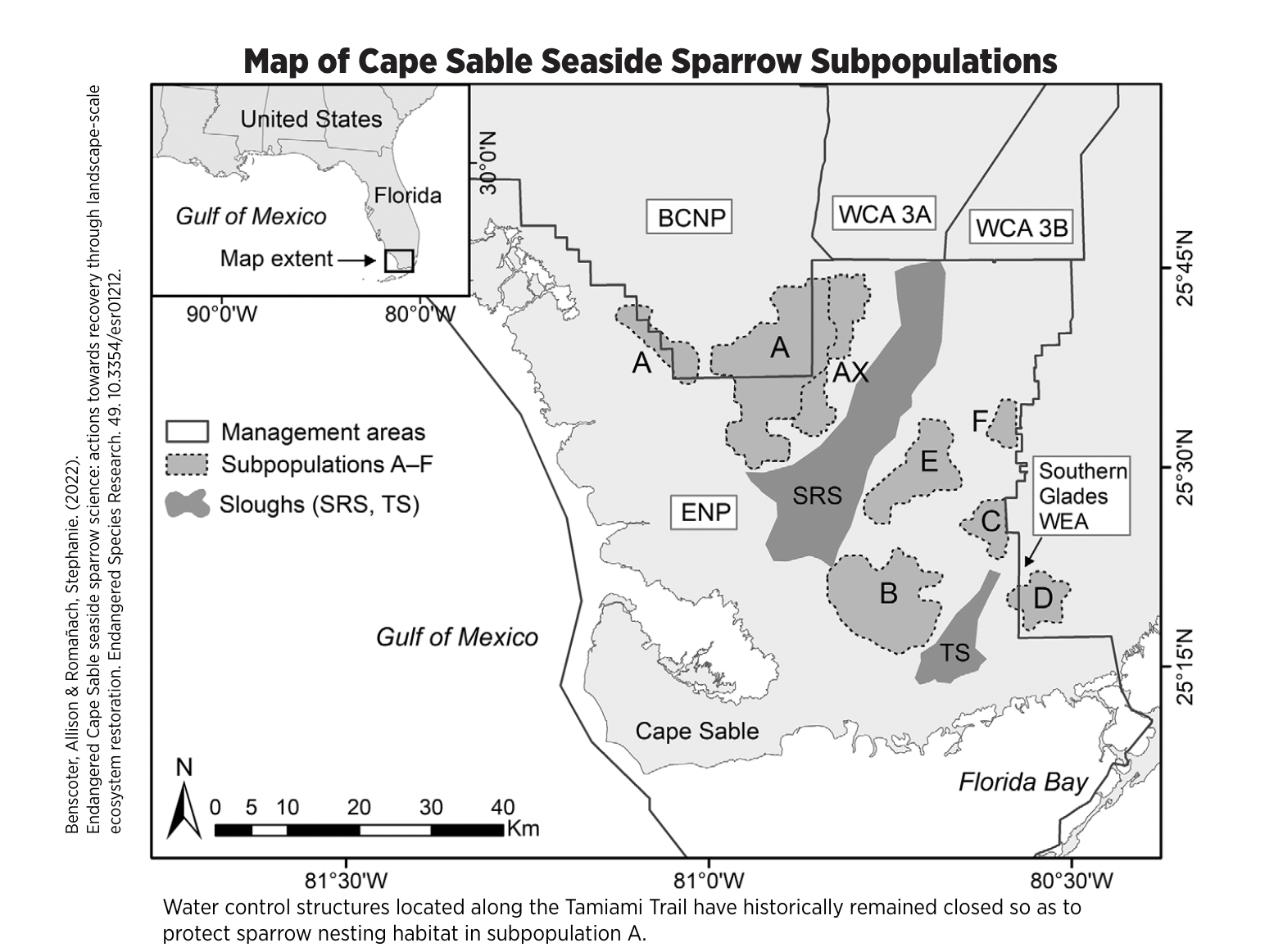What is the Cape Sable Seaside Sparrow?
A sub-species of the Seaside Sparrow, the Cape Sable Seaside Sparrow is a non-migratory bird with an extremely limited range – this unique bird calls the Florida Everglades home.
Very secretive, they are normally heard but not seen. Smaller than a human hand, they sport bright yellow feather patches above their eyes. They thrive in habitats known as “marl prairies” – which part of the year are freshwater wetlands full of waving sawgrasses.
Is the Cape Sable Seaside Sparrow endangered?
The sparrow was listed as endangered in 1967 due to its limited range and habitat threats caused by drainage of the Everglades south of Lake Okeechobee as part of the Central and South Florida Project. This initiative was meant to provide flood control for communities south of the lake.
The sparrow prefers the wetland prairies in and around Shark River Slough and Taylor Slough for nesting habitat, and six distinct sparrow subpopulations — labeled A through F — have been identified across the Central and Southern Everglades. According to the U.S. Fish and Wildlife Service, subpopulations B through F are “stable or increasing.” But numbers in subpopulation A, which is located along the northwest portion of Shark River Slough and to the south of Water Conservation Area 3A (WCA 3A), have continued to decline. Right now, there are limited pathways for water to flow out of WCA 3A, which, when combined with the billions of gallons of water from Everglades Agricultural Area (EAA) runoff and unseasonal rainfall, results in WCA 3A water levels that are too deep.

To keep the habitat drier for sparrow subpopulation A during nesting season, some water control structures are closed during parts of the year. The S-12 and S-343 water control structures can directly impact sparrow habitat, but have limited flow capacity and do little to reduce overall water levels upstream in WCA 3A. Other structures with the capacity to impact water levels in WCA 3A without impacting sparrow habitat remain closed or are under construction, as in the case of the Tamiami Trail bridging effort.
Even so, the sparrow gets blamed when water levels in WCA 3A are higher than desired.
How has the habitat been changed?
The sparrow didn’t create the conditions that threaten its existence. Human efforts to drain the Everglades to create the EAA, provide for flood control, and foster urban development altered the natural volume, timing, and flow of water to Everglades National Park and Florida Bay. The Comprehensive Everglades Restoration Plan and restoring historic flows to Northeast Shark River and Taylor Sloughs are the remedies for the Everglades and the sparrow. Despite recent accelerated progress and unprecedented funding investment, restoration has suffered from numerous delays since being approved in 2000.
Why is this a problem for sparrows and people?
2023-2024 has been a particularly wet year as the result of a supercharged El Niño season. The additional rain has caused large amounts of runoff from farms within the Everglades Agricultural Area and other sources to flow south. While water in the Everglades is a good thing, too much water is causing flooding of nearby Miccosukee land, especially tree islands of cultural significance to the tribe that hosts a unique community of flora and fauna.
To mitigate this, the flood control structures that normally remain closed to protect sparrow habitat are actually open. Unfortunately, the open structures have not appreciably reduced the flooding caused by heavy rains this year, but they have impacted sparrow nesting habitat.
How can we reduce flooding while protecting Cape Sable Seaside Sparrows?
More water is flowing south from the EAA, but we do not have additional routes for the water to eventually make its way to Florida Bay. We must keep up the momentum in Everglades restoration to increase the distribution of water south so the WCA 3A area does not absorb all of the excess flood waters flowing from upstream agriculture and communities. Parts of the Tamiami Trail have already been elevated, as an example, to allow additional water to move south. As this project continues, more water will be able to flow, reducing flooding issues.
Other projects like the Western Everglades Restoration Project will also create additional flow pathways for WCA 3A water. These complementary projects will be integrated into operational plans and will provide high-water-level relief once online.
Audubon has been encouraging conversations between experts, regulators and land managers on the feasibility of a captive breeding program (similar to the one currently underway for Florida Grasshopper Sparrows) to ultimately boost population numbers and establish additional populations in the bird's historic range.
For more information on the Cape Sable Seaside Sparrow, download our fact sheet HERE. To be an advocate for Cape Sable Seaside Sparrows, and other birds and the places they need, sign up for our email list HERE.
This article appeared in the Spring State of the Everglades report. Click here for more information.




